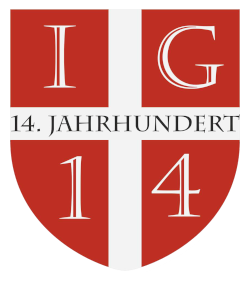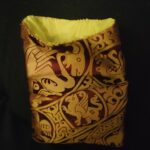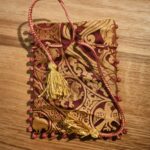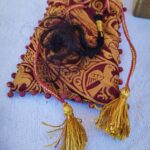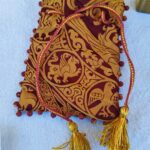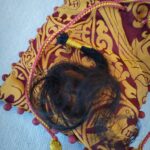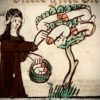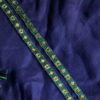A lock of hair as a love token
Today, I would like to talk to you about a special substance in medieval material substance, human hair.
The incredible amounts of symbolic aspects of hair in the middle ages are a huge topic which many historians have written about. At the bottom of this article, I linked a couple of interesting papers and books for you to consume if you would like to know more. What I want to talk about today, however, are locks of hair as rememberance aids and love tokens. The tradition to gift locks of hair to lovers or work hair into love gifts, is a practice that we know particularly well from 19th century tradition and many objects containing human hair remain preserved to us today from this century. And just look at these fantastic lace ribbons made from human hair from the early 17th century!
But even earlier, human hair was emotionally, magically and erotically loaded material, a piece of the body of a special someone that could be cut off, gifted away and kept for a long time as a talisman.
Hair locks have been particularly interesting as reliquaries from saints and magical objects. Charlemagne for example owned a talisman talisman pendant, containing shards of the holy cross and hair from the virgin Mary (allegedly). And in the records of the inquisitor Jacques Fournier from the 14th century, he writes about a family, keeping fingernail clippings and hair of their ancestors in their house as a magic spell to promote good fortune.
In his treatise on love, „De Amore libri tres“ (Three books of love), the author Andreas Capellanus writes at the end of the 12th century:
“A lover may freely accept from her beloved these things: a handkerchief, a hair band, a circlet of gold or silver, a brooch for the breast, a mirror, a belt, a purse, a lace for clothes, a comb, sleeves, gloves, a ring, a box, a keepsake of the lover, and, to speak more generally, a lady can accept from her love whatever small gift may be useful in the care of her person, or may look charming, or may remind her of her lover, providing, however, that in accepting the gift it is clear that she is acting quite without avarice.”
The tradition, to make intimate little gifts to lovers, can mainly be found in medieval lyric, but it may also be found in extant objects and archeological record.
Common gifts that we can still admire in museums today, are objects that the person receiving the gift may use in an intimate way or close to their body. Belts, hair parters or combs for example.
This kind of symbolic intimacy is also conveyed by hair locks as gifts, mainly from women to men (since female hair often has a more secretive character due to it being hidden under veils most of the time), but also the other way around. For example, in the adventure story “Le Chevalier de la charette” by the poet Chretien de Troyes in the 12th century, which is included in a row of stories around king Arthur, Lancelot finds the comb of queen Guinevere on a stone, while riding astride, still containing strands of her hair. He picks up the comb, presses the hair to his face and lips and thereby feels close to his beloved.
Locks of hair are gifted as aide memoires, when one of the partners is going on travels. In the french tale “Aucassin et Nicolette” from the 12th century, the lovers part:
“Shore she then one golden tress, thrust it in her love’s duress; Aucassin hath seen the gold, shining bright in that dark hold, took the lock at her behest, kissed and placed it in his breast, then once more his eyes were wet for Nicolette“
And in the french tale “Castelain de Couci et de la Dame de Fayel “ from the 14th century, locks are exchanged before he lovers say goodbye.
Human hair was also worked into belts, hair ribbons or pieces of clothing is mentionned several times.
For example, in the poem “Cligés” by Chretien de Troyes from the 12th century, the son of the greek emperor, Alixandre, comes to the realm of king Arthur, where he meets Arthurs niece, Soredamor (Just…. don’t question this. Medieval authors love to throw historical figures and different stories together and make something new from it. And who are we to criticise that, watching cinematic masterpieces like “Alien vs. Predator”…).
Soredamor, secretly in love with Alixandre, gifts him a shirt, sewn with a thread made from her own golden hair. The hair in this instance, has a magical use as well, since it is supposed to impose a magic spell on Alixandre so he can admit his secret love for Soredamor as well.
A very special piece of medieval hair work can be found in the Greenland Textile finds, treated in “Woven into the earth”, where an almost perfectly preserved filet or necklace from twined, blond human hair was found inside a medieval hut, the so called “Farm under the sand”, which was probably made as a love token. (Seite 108)
So, why am I telling you all of this? Because it’s interesting to me of course. And since I am not a historian but a living historian, I had to of course make these sources into a piece for my display table on the topic of women in the middle ages. A lock of hair as a love gift in a silk purse. It was supposed to open conversations with visitors on love, marriage and friendship in the middle ages, on medieval hair fashions and on the practice of hair veiling in women. And it worked!
The lock was kindly donated to me by a person dear to my heart, yellow and red silk, gold thread and coral beads have been used in the purse and the ribbon to close it, is a special item from Martina, which she kindly gifted to me. It was made completely by hand from unraveling the raw material (silk cocoons) to spinning the tread, to plant dying to fingerlooping it and is a very precious piece of textile for me. Here are some impressions of the piece:
Zum Weiterlesen:
Symbolic meanings of hair in the middle ages
Objectifying Love: Ladies and Their Tokens, Saints and Their Relics in Chrétien de Troyes
A cultural history of hair in the middle ages
Heart Economies: Love Tokens and Objects of Affection in Twelfth-Century French Literature
Thresholds of Medieval Visual Culture
Montaillou: Cosmology and Social Structure
The hair as Remembrancer: Hairwork and the technology of memory
Eyebrows, Hairlines and Hair less in Sight
Hair care and hair dos in the middle ages
Ambiguous locks: An iconology of hair in medieval art and literature
Related Posts
The following posts might interest you as well:

